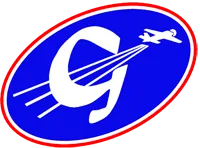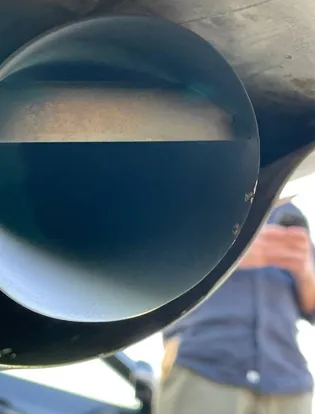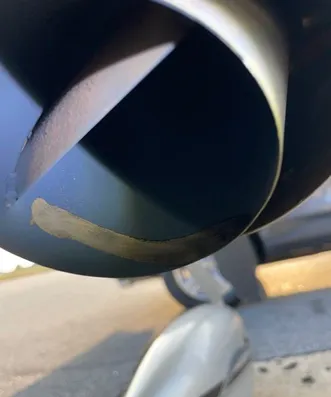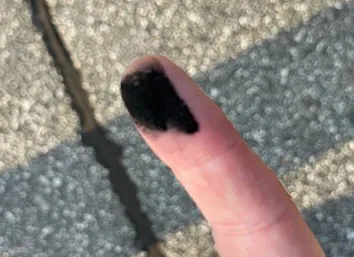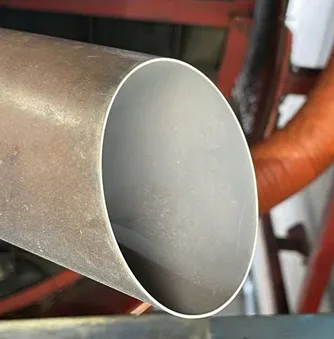Frequently Asked Questions
G100UL Unleaded Avgas
G1What is the octane of G100UL unleaded avgas?
G100UL is a 100-octane avgas. During FAA approved detonation testing, the detonation protection from use of G100UL avgas was the same or even exceeded that of a corresponding ASTM D910 100LL. That detonation testing was personally observed by highly experienced FAA propulsion engineers.
G2Other than being lead-free, are there other benefits to G100UL avgas?
Spark plug maintenance and replacement intervals will be improved in the absence of metallic deposits from lead. In addition, it is likely that over time oil change intervals will double. Without the lead, it is likely that a synthetic oil will become available and that will further increase oil change intervals and reduce the hassles associated with oil changes.
Operators of air-cooled race car engines have reported substantial improvements in the TBO of those high performance engines after changing from leaded to un-leaded gasoline. It remains to be seen if that may also apply to air-cooled piston aircraft engines.
Given the results of the oil analysis shown below, over time we may be able to extend the TBO of our aircraft engines by 50% or 100%.
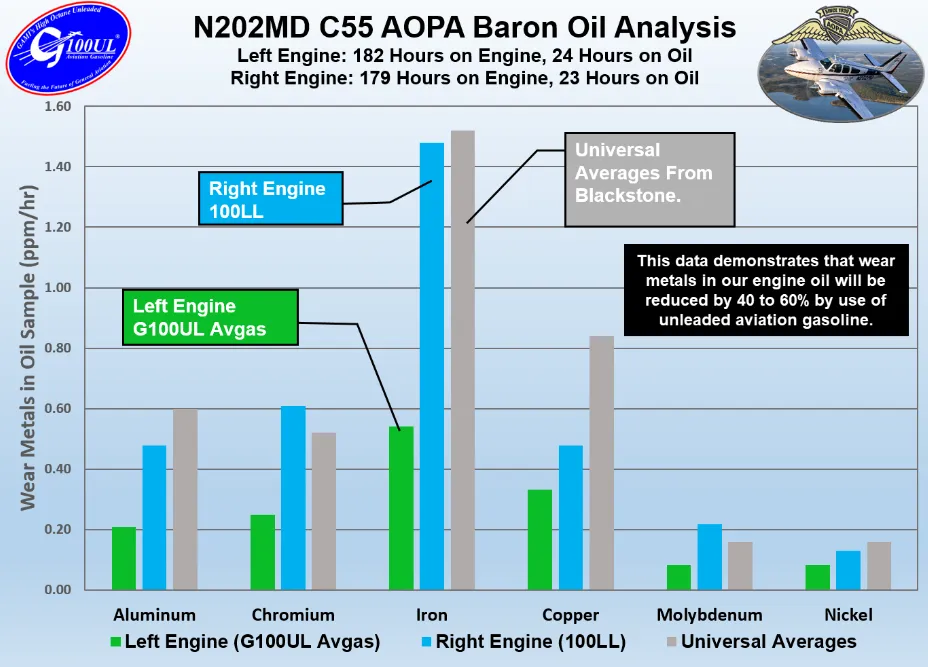
G3What are the operating limitations, concerns, or exclusions with use of G100UL avgas?
They do not change. G100UL avgas is basically transparent to the engine, aircraft, and pilot.
G4Will the operation of my engine change with G100UL avgas?
No. Pilots with sophisticated engine monitors may be able to detect small, negligible, changes in EGTs compared to operation on 100LL.
G5What changes will I have to make to my engine and/or airframe to use G100UL avgas?
No mechanical modifications are required. An STC placard will be placed on the engine. STC appliques will be applied to refueling ports and a simple addition to the AFMS is made in accordance with the simple instructions.
G6Are there any airspeed or range implications with the use of G100UL avgas?
Essentially no. At the same volumetric (GPH) fuel flow and a LOP mixture, the aircraft will be one or maybe two knots faster, due to the slightly higher volumetric energy density. Likewise, with full tanks, the range of the aircraft will be the same or possibly increase by around 1%. However, G100UL avgas weighs around 6.15 to 6.3 lbs. per gallon, rather than 6.0 lbs. Use 6.25 lbs. for W&B calculations.
G7What is the color of G100UL avgas?
As produced it has a green tint. That results from adding a blue dye to the refiner fuel blend. When further mixed 50/50 with blue 100LL the color will continue to be green or shift to blue-green.
G8AOPA reported that the G100UL exhaust in their Baron was a black powder. How is that different from 100LL?
Based on 14 years of operating experience, we see the type of “black powder” reported by AOPA only when the engines are operated with excessively rich mixtures. Immediately after that AOPA report went online, we had the opportunity to conduct a little experiment!
As noted in FAQ #G6, G100UL avgas has a higher energy content (BTUs / gallon) than 100LL. That is a good thing! While the difference is small, it does make it more important to follow good mixture management practices.
Example: Our TN SR22 (N223TN) is normally operated in cruise at about 80% of its rated 310 BHP and 80 degrees F. LOP. However, during a trip from GAMI down to Marietta, Georgia, we waited until we were about 40 minutes ETA, and then switched to 30” x 2500 RPM and FULL RICH. In that case, that was about 350-400 degrees ROP! Yes, around 36 to 38 GPH. Continuously, for forty minutes. After we landed and made the necessary relief stops, we went back out to the airplane and took the following three photographs:
The first photo [1] shows the dark black powder in the tail pipe after 40 minutes of very rich operation. [2] Same tail pipe after a single quick “finger wipe”. [3] George Braly’s index finger! The layer of black powder is less than about 1 (one) millimeter thick! We have never observed any accumulation, as it is simply “blown” out the exhaust when the layer gets to be any thicker than what is shown in the photographs. See the “normal” condition of the tailpipe, in photograph [4] below.
This is the tail pipe from the same TN IO-550 engine in GAMI’s test cell - after hundreds of hours operating on G100UL - with the mixture adjusted in accordance with normal good operating practices!
Q. So what is that black powder? A. It appears to be nothing more than common “carbon black” - - in a rather pure form. We are having it analyzed to be certain. If it turns out differently, we will update this FAQ.
AOPA also mentioned the same black powder on the lower spark plugs on the left hand engine that burned G100UL. However, again, unlike the deposits from 100LL, those deposits do not “stick” or “adhere” to the spark plugs. A short blast of shop air and the powder is completely gone! See the below photograph of the spark plugs.
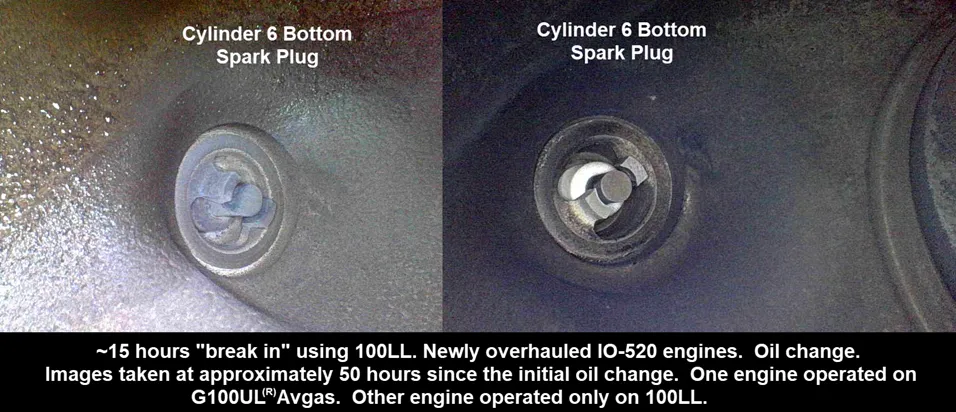
G9AOPA also reported some brown staining of the paint near the fuel port on the wing? How does the owner prevent that?
Routine “refueling hygiene”! What a concept!
Aviation gasolines typically contain dyes to distinguish different grades (octane) of fuel. G100UL® Avgas is no different. The blue dye in 100LL can leave stains on aircraft painted surfaces. G100UL Avgas can leave a brown stain if fuel is spilled and the spill is not promptly “cleaned-up”. In order to provide the extraordinarily high detonation performance of G100UL avgas, a very small portion of the fuel composition includes a molecule that reacts with ultraviolet (UV) from sunlight and creates the potential for staining. Ethanol car gas can cause deterioration of the paint on your car. This is not an issue unique to aircraft. (Note G100UL avgas does not contain ethanol!)
Therefore, you should monitor the refueling of your aircraft unless you otherwise have assurance that the refueling provided by your FBO will include proper “refueling hygiene”.
G10My airplane has a MoGas STC. Can I mix G100UL avgas with MoGas?
Yes. Comingling of G100UL Avgas and other gasolines approved for use in your aircraft is specifically authorized in the limitations section of the STCs. However under no circumstances should you use any gasoline with ethanol.
G11I have heard rumors about problems with other (PAFI / EAGLE) candidate unleaded fuels including cold weather starting problems, paint stripping from spillage at the filler for the gas tank, and metal additives that fouls spark plugs. Has GAMI addressed and avoided all of those issues?
Yes. Successful cold weather operational starting and extensive flight-testing has been conducted, including by an FAA test pilot, all with no difficulties. The “paint stripping” you may have heard about was unique to some particular components in an earlier PAFI fuel formulation that had nothing to do with G100UL avgas. G100UL avgas has demonstrated no evidence of causing any break down of paint on aircraft surfaces. However, if you spill fuel on a painted surface, it should be promptly wiped up with a clean rag, to avoid staining over time. See G9 above for more information and detailed guidance on handling incidental fuel spills during refueling of your aircraft.
Further, at GAMI’s request, ERAU, as a 3rd party, completed a highly successful 150 hour engine durability test conducted on an engine that already had 1400+ hours of operation on 100LL. The post-test engine teardown demonstrated the engine and combustion chambers were noticeably cleaner at the end of that 150 hours operating on G100UL avgas than before the test started. That testing at ERAU was closely monitored by the FAA with personnel out of the Atlanta Aircraft Certification Office.
G12Are there any known material compatibility issues in aircraft, engines, storage tanks or transportation systems?
After extensive testing, no compatibility issues have been identified in any aircraft, engines, storage tanks or transportation systems. G100UL avgas is a functional drop-in replacement for 100LL avgas, fully fungible with 100LL and other aviation gasolines, and ready to be used within the industry’s existing infrastructure.
G13Do you have any testing or specifics related to how long the fuel lasts in storage?
The shelf life of G100UL avgas is at least as good as the current 100LL. We have tested G100UL stored for more than 3 years with excellent results. The G100UL has the same vapor pressure and components as 100LL so depending on storage conditions can lose the “light ends” over time if not properly stored, but no worse than the current 100LL. There is virtually no tendency to form “gums” as can happen with 100LL as the G100UL has certain antioxidants in it as a part of its base formulation.
G14If I purchase the STC for G100UL, is it still legal to use 100LL if that is all that is available?
Yes. Absolutely. In fact, you can switch back and forth and use any combination mixed together in your fuel tanks.
G15GAMI has reported that after deployment of G100UL Avgas that it may be possible to increase the horsepower on a number of the turbocharged engines due to the higher supercharge rating of G100UL Avgas. Do you have any FAA detonation data that is already approved that would support that plan to increase the horsepower of the turbocharged engines?
Yes. As part of our detonation testing with the FAA on site in the GAMI Engine Test Stand control room (December 15 & 16, 2020) we demonstrated the operation of a high compression (8.5:1 with 22 degrees of spark advance and max rated power of 310Hp) engine operating at a measured 380Hp which corrected (to standard day) horsepower of 414Hp, or about 133% of its previous maximum certified standard day horsepower. That was done with the engine operating conditions deliberately maintained at the very highly elevated levels required by the FAA (14 CFR 33.47) for detonation testing of a new engine or fuel. An excerpt from the FAA approved final detonation report reflecting that data can be downloaded, here.
G16Recently, there has been a lot of information demonstrating that the two remaining PAFI – EAGLE candidate fuels (both with ETBE as a key octane enhancing component) will not be suitable for the high performance engines. If those fuels are finally approved and adopted, and without G100UL Avgas, then all of the high performance aircraft in the piston fleet would be grounded or be required to be derated or spend $20 or $30K to do a Lycoming top overhaul with new cylinders - - if that were even possible. Do you have any information or data that you can release that can provide assurance to the owners of the high performance aircraft that their engines will have the same (or, hopefully, better) detonation margins using G100UL Avgas than exists with their current operation on 100LL?
Yes. See the Executive Summary that was included as part of the FAA approved detonation test report at the conclusion of the years of detonation testing of G100UL Avgas. There is a lot of detailed information in that report. After studying that, if you still have any questions about the suitability of G100UL Avgas to be used in the high performance engines, please send you questions and concerns to GAMI.
G17Why does G100UL Avgas not use ETBE like Swift’s 100R and Lyondell/Vp UL100?
GAMI investigated the use of ETBE. Laboratory and full scale engine tests established that ETBE could not provide the necessary octane increase required for transparent use on all of the higher performance aircraft engines to prevent destructive detonation.
In addition to the lack of octane performance, ETBE is an “ether” which has always been recognized as having the potential to cause drowsiness or even unconsciousness in the event of a fuel leak in the cockpit. That is a real concern for safety of flight.
Most experienced pilots will have encountered the odor of 100LL from seepage from the multiple fuel lines, valves, and electric boost pumps that are found inside the cockpits of our aircraft.
However, more important than those considerations, this past March (2025), the International Agency for Research on Cancer (I.A.R.C.) released data from their upcoming Monograph on their study of the carcinogenicity of ETBE in gasoline to humans.
The animal evidence and the mechanistic evidence is now deemed sufficient to establish that human exposure to ETBE (via vapor-inhalation) causes human cancer.
Based on that data, it is doubtful that FBO owners would want to run the risk of exposing their employees to ETBE during aircraft refueling multiple times each day.
In order to do that safely, those employees refueling your aircraft would likely have to wear respirators. Note: Automotive gasoline distribution has vapor recovery systems and has special designs for the refueling at your car that greatly limits any exposure, as compared to aircraft refueling.
One very experienced PhD chemist reviewed the IARC data from the preliminary report in the British Journal “Lancet” and observed:
The evidence for cancer in humans from exposure to ETBE is stronger than the evidence for human cancer from exposure to Roundup herbicides, which has resulted in hundreds of millions of dollars in adverse monetary judgments in the courts.
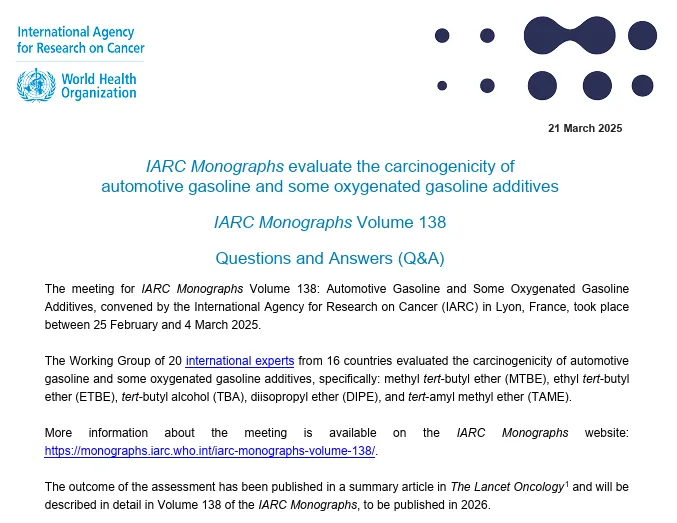
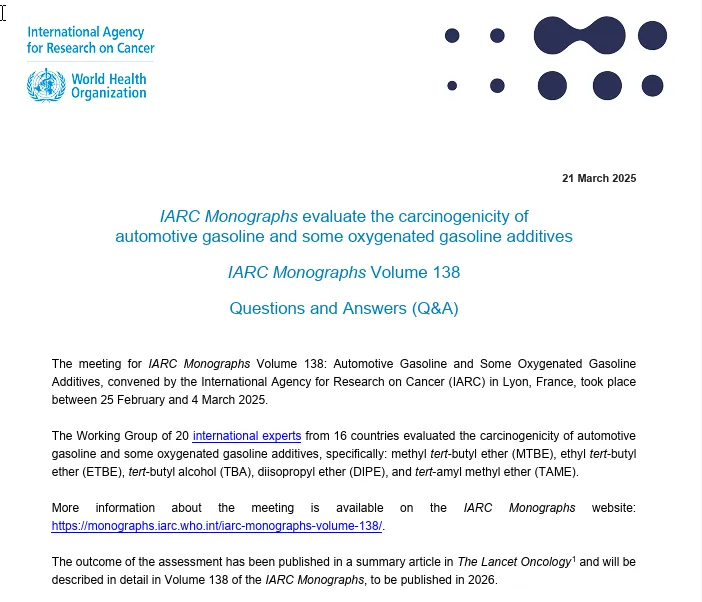
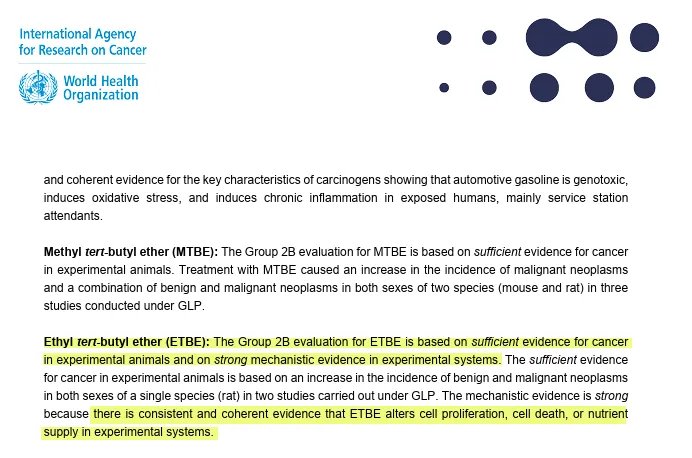

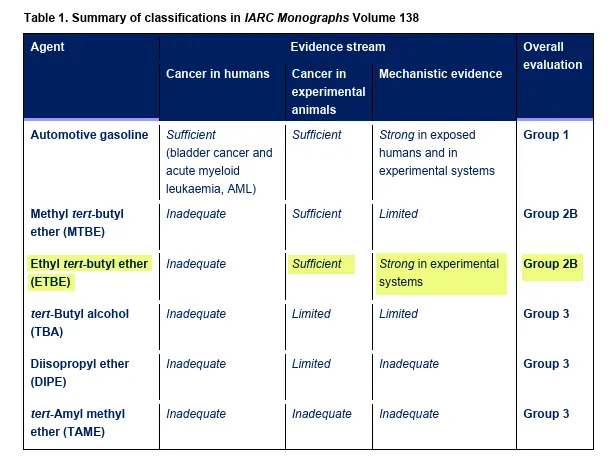
G18Ben Visser has written several times asserting that lead in aviation gasoline was necessary to prevent “Valve Seat Recession” (VSR). However, I have never seen any data supporting that widely discussed claim. Has GAMI investigated this issue and is there any data to demonstrate that for aircraft engines that use of proper (octane) unleaded avgas does or does not result in accelerated VSR?
Ben Visser is a frequent writer in GA News on the subject of Aviation Gasoline. He is a retired Shell Oil Company fuel expert and is well respected in aviation fuel issues.
He has written several articles in which he repeatedly states that lead is essential to protect valve seats from excessive wear and “VSR”. However, Ben has not provided any data nor, of more importance, data specific to aircraft engines with their historically hardened valve seats.
Ben’s most recent article is found here: https://www.generalaviationnews.com/2025/08/15/a-warning-from-the-past-for-unleaded-avgas/
All of Ben’s comments on this subject over the years may fall into the category of confusing “correlation” with “causation.”
So far, as we know there is no controlled comparison data found in published reports supporting the claim that the “Lack of Lead in Avgas Causes VSR”.
However, to the contrary: THERE IS published, and controlled comparison data, supporting the knowledge that, for leaded avgas vs unleaded avgas, there is no significant difference in valve seat recession when each of the two fuels is operated in identical aircraft engines under identical conditions.
See the following: FAA report TN89 - Comparison Between Unleaded Automobile Gasoline and Aviation Gasoline on Valve Seat Recession in Light Aircraft Engines
That FAA report, prepared in 1989 at the FAA William J. Hughes Technical Center establishes, by well controlled, “back-to-back” comparison testing that the absence of lead in Avgas does not cause valve seat recession.
The abstract to that report concludes with the following statement:
“Results show valve seat recession using unleaded autogas fuel was not significantly different from 100LL avgas.”
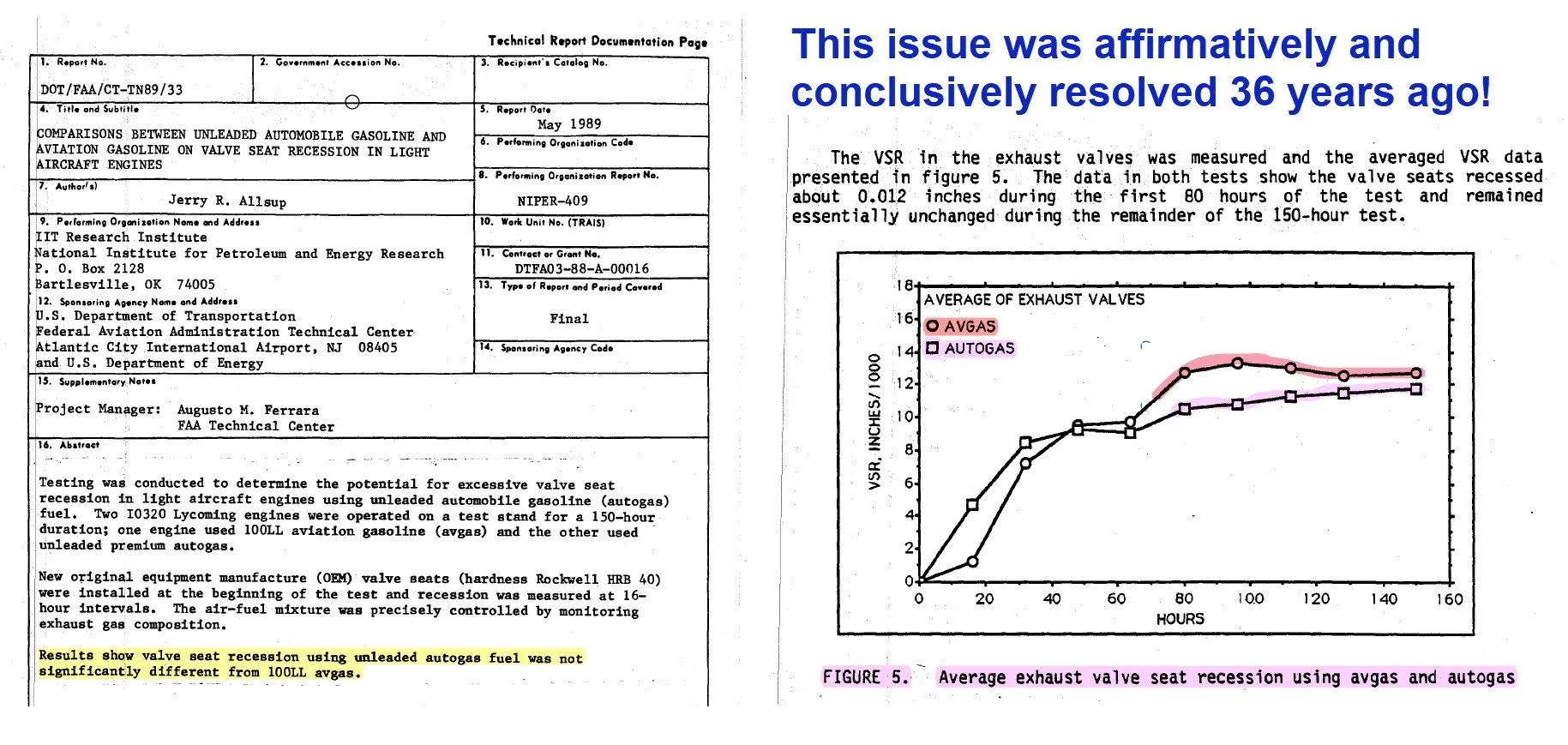
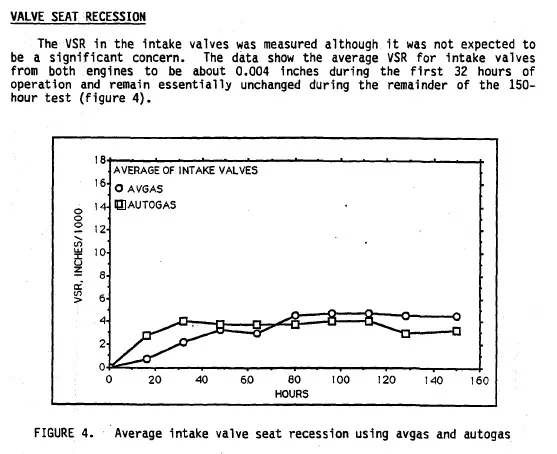
So, that raises the question - what caused the VSR reported from University of North Dakota with their Lycoming 360 engines?
AS GAMI reported at OSHKOSH, a year ago (2024) - GAMI’s engine testing, using FBO UL94 Avgas, has conclusively demonstrated that those engines used at UND will detonate almost continuously if operated on 94UL - (important) - under the specific operating conditions used at UND.
The problem at UND was NOT lack of lead. The problem was lack of OCTANE - for the conditions under which those engines were routinely operated.
In our judgment, Lycoming should have never approved those engines to operate on 94UL - without, at a minimum - modifying the Flight Manuals so that the engines could not have been operated under the power and Fuel/Air ratio parameters used at UND.
There are other published reports in the Engineering literature that also demonstrate that if the peak internal combustion pressures are controlled to be the same during the testing, that there is no VSR even in automotive cars, when UL auto gas is compared to leaded avgas.
Unfortunately - our small General Aviation Industry continues to be plagued by the use of “Old Wives Tales”, field reports and rumors.
It is important for pilots and mechanics to review good data and believe the direct aviation engine data - rather than anecdotal automotive opinions from 40 years ago, and without any aviation-relevant data to support those opinions. Believe the data.
Absent data of equal or better quality than the taxpayer funded VSR study conducted by the FAA in 1989 - This concept needs to be put to bed!
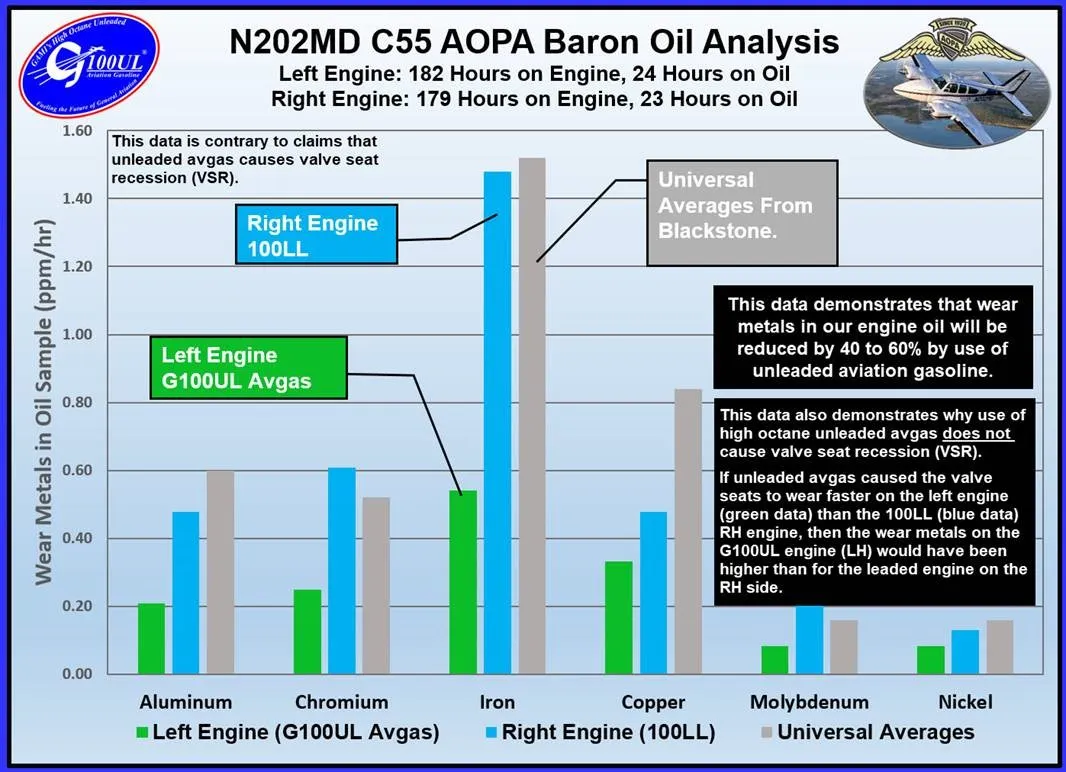
AML-STC
A1What is an AML STC?
An “Approved Model List” STC is a well-established FAA method to provide an orderly process for the expansion of the applicable make & models of aircraft and engines to any modification of the original aircraft or engine. Typically, the initial AML STC is issued with only one or a few make & model aircraft or engines in the “AML” list attached to the STC. Thereafter, based on additional review of data, further makes and models are added to the attached “AML” list.
A2What will the STC cost?
The STC pricing is based on engines and horsepower, in a manner similar to the pricing for other fuel STCs that have been available for low octane gasolines.
A3What is included in the STC paperwork?
A very short Approved Flight Manual Supplement (AFMS) and placards to be installed around the fuel filler ports on the aircraft and one on each engine. There is a short set of routine I.C.A’s (Instructions for Continued Airworthiness) and Installation Instructions for the placards. The same as any other normal STC.
A4Will G100UL avgas work on the Warbirds at full rated power?
The detonation testing data fully supports that application. The standard ASTM detonation test for operation at full take-off power (D909) demonstrates that G100UL is superior even to the old 115/145 “Purple” avgas used on DC-7’s and Constellations. GAMI anticipates G100UL avgas will be adopted for “Warbird” operation under the same limitations, if any, as are appropriate for operation with 100LL. However, detonation testing and laboratory data supports a “full rated power” application. One Warbird, a P-40 Warhawk has already been approved to use G100UL avgas!
Fuel Testing and Certification
F1Is G100UL avgas approved by the FAA?
The initial STCs with the initial Approved Model Lists were signed and approved by the FAA in July 2021. We started with one STC for an initial group of aircraft and a separate STC for their corresponding engines. Since then GAMI worked tirelessly to complete the task and in September 2022, a little over a year later we received AML STC approval for use of G100UL avgas with every spark ignition piston engine and every airframe using a spark ignition piston engine in the FAA’s Type Certificate database.
F2Did any FAA personnel travel to GAMI’s facility in Ada, Oklahoma and directly observe, witness, or supervise the testing of G100UL avgas?
At various times, different combinations of over twenty senior FAA engineers and program managers traveled to Ada, Oklahoma (and other locations) and personally observed flight testing, engine durability testing, post-test engine tear down inspections, material compatibility testing, flight testing, and “back to back” comparison engine detonation testing of G100UL avgas and 100LL. In addition, there was a further group of ten or more senior FAA certification personnel who were involved in the G100UL avgas approval process.
F3Were there any new or novel discoveries or innovations that led to the successful approval of G100UL avgas?
Yes. There were several “break-through” discoveries in the 2012-2014 timeframe. In the fall of 2015, after an extensive, year-long internal technical review, the results and applicability of two of those discoveries to the certification of engines for operation on unleaded aviation gasoline were approved by the FAA after a formal G100UL project “Issue Paper”. This process is the most rigorous review process used by the FAA for any certification activity.
F4Did GAMI engage any subject matter experts to assist with the technical issues that were identified during the development of G100UL avgas?
Yes. GAMI has had extensive technical support from one of the world’s premier specialty chemical companies, which provided substantial technical assistance with the development of the test protocols for assuring the production quality control of G100UL. In addition, at various times, GAMI sought out and obtained technical assistance by three former refining industry employees with specific, long term, experience in relevant areas.
F5What specific tests were conducted?
The list of tests conducted is comprehensive and extensive. Among those:
- Material compatibility testing was identified as an early go/no-go requirement that took nearly a year to complete.
- Hot day, hot fuel, high-altitude and engine restart tests were completed early in the process.
- Early “screening” detonation testing successfully completed, as another go/no go “check-box.” Later, there was an exhaustive series of detonation tests conducted, as noted below.
F6Detonation testing has always been the main problem. Were the detonation test plans and the testing approved by the FAA?
Yes. The detonation test “means and methods” were intensely scrutinized and reviewed by the FAA. As far as GAMI is aware, GAMI now has the only modern, internal cylinder pressure sensor based, aircraft engine detonation test methodology that is specifically approved by the FAA through its highest level of oversight and documented through the formal FAA “Issue Paper” process. Note: GAMI and its “sister” company Tornado Alley Turbo, Inc. have previously conducted numerous, successful, FAA approved detonation certification tests on several critical turbo-charged piston aircraft engine applications with several millions of hours of successful field experience.
F7Was the FAA present on site (in spite of COVID) to observe the Detonation Testing?
Yes. The FAA spent the better part of two days in the GAMI test cell in Ada, during that detonation testing. Other FAA personnel simultaneously observed the engine runs remotely through remote links to the four test stand computer screens.
F8What was the compression ratio, Manifold Pressure and the highest horsepower achieved during detonation testing that successfully passed a formal FAA 14 CFR Part 33.47 Detonation test?
At the conclusion of the two days of detonation testing, GAMI elected to complete an optional test item from the FAA approved test matrix.
That test item was to determine the maximum Brake Horsepower (BHP) at which the 8.7:1 CR IO-550 turbo-charged test engine could be operated and continue to pass a standard Part 33.47 FAA full power detonation test. With redline cylinder and induction air temperatures, the engine easily operated at 41.4” MP, 380 actual BHP (414 BHP when corrected to Standard Day conditions). We were unable to determine how much more additional HP could be obtained because the pressure relief “pop-off” valve on the induction system was limiting further increases in manifold pressure.
F9GAMI started this project over 10 years ago. Why has it taken so long to get G100UL avgas approved by the FAA?
There was a lot of new and novel fundamental Research and Development that was required. There were some inevitable changes in FAA personnel over that time-period that slowed the progress. In addition, GAMI funded all of the entire R&D effort from business cash flow.
F10Were aircraft and engine original equipment manufacturers (OEMs) involved in the development of G100UL avgas?
Early in the development of G100UL avgas both Lycoming and Continental sent engineers to GAMI in Ada who evaluated G100UL avgas and flew a turbocharged Cirrus operating on G100UL avgas in one wing tank and 100LL in the other. There was no objection raised by either of those two early OEM engine manufacturers to the performance of the G100UL avgas.
In addition, Cirrus Aircraft had one of their senior managers come to Ada. He was an experienced pilot who also flew the G100UL avgas in a Cirrus aircraft to evaluate its performance against 100LL.
Cirrus also conducted extensive material compatibility testing of G100UL avgas with their composite fuel tank materials using their FAA approved testing protocols. That was very helpful and timely.
F11Why did GAMI elect to pursue the STC certification path rather than join the FAA “Piston Aviation Fuel Initiative” (PAFI) project?
Primarily, because that process began three years after GAMI had started the G100UL avgas STC project and there was no mechanism within the PAFI project for GAMI to obtain “credit” for the substantial certification work, which the FAA had already approved. There were additional reasons.
F12Are there any new toxicity concerns with G100UL compared to 100LL?
The components in this new, high-octane, unleaded avgas have been carefully vetted and no new toxicity issues have been found. A draft Safety Data Sheet (SDS) has been developed in consultation with world-class experts in that field. That new SDS is similar to and consistent with existing SDS documents for other transportation gasolines widely used in the marketplace.
F13There are reports & claims that G100UL damaged paint on the bottom of wing of an older Mooney in California. Do you have data that shows aircraft painted surfaces exposed to G100UL Avgas for hours or days?
Yes. See the following: linkThose three Beechcraft painted louvre panels were immersed in:
- FBO 100LL w additional added (~15%) extra toluene
- G100UL Avgas (same production batch as distributed in California)
- FBO 100LL
At the time the photographs were taken, they had been soaking for over a week.
There is no visible evidence that the paint has been damaged by the extended exposure of those panels to any of those three different fuel chemistries.
Distribution and Availability
D1GAMI is a small company. How is GAMI going to create the infrastructure and finance the inventory to produce millions of gallons of G100UL avgas?
GAMI is collaborating with a very large aviation fuel producer to oversee the logistics of production. The four major distributers of aviation fuels for general aviation (Avfuel, World Fuel, TITAN and EPIC) have all been invited to make arrangements to transport fuel to FBOs in California. Unfortunately, as of Oshkosh, 2023, none of those four distributors has begun making arrangements to do that. If that does not happen promptly, then GAMI has an alternative plan to begin moving G100UL avgas to airports in California, Oregon, & Washington. Later, we anticipate expanding the distribution throughout the rest of the Country.
D2Are there any concerns regarding price or availability given the proprietary formulation of G100UL and competitive nature of high-octane unleaded avgas?
GAMI’s plan is to ensure any legitimate distributor and supplier of G100UL avgas non-discriminatory pricing and access to all available supplies. GAMI believes the contract and licensing terms of the G100UL avgas producers, blenders and distributors will result in the elimination of some existing transportation-cost-related market inefficiencies arising out of existing proprietary sourcing and distribution of 100LL.
D3Which airports will be the first to have G100UL avgas?
The first airports to offer G100UL avgas are KRHV and KWVI in California. Please check our availability map for more information.
D4How long will it take in order for G100UL avgas to be widely or routinely available?
As rapidly as the supply chain and associated infrastructure can be put in place. GAMI anticipates that the availability of G100UL avgas will expand nationally over a period of a few years, at a pace determined by the number and location of new producers and blenders, and any mandates by the Federal and local governments. However, pending (as of Oshkosh 2023) congressional action could have the effect of delaying early deployment of G100UL avgas.
D5Will there be specific FBOs that are unable to get access to supplies of G100UL avgas due to proprietary licensing to certain suppliers and vendors?
No such limitations are expected. At present GAMI intends to license production of G100UL avgas to all qualified producers who want to produce and/or distribute G100UL Avgas.
D6I fly from airports in Northern California. I am concerned 100LL will be banned before G100UL is widely available. Will there be any priority for airport locations in regions of the Country that have a history of high profile environmental activity?
While that is a concern, it is unlikely that any significant number of municipalities will ban 100LL in the absence of an alternative. GAMI is aware of that potential issue and is actively working to mitigate that possibility. Unfortunately help in that effort from traditional fuel distributors has not been forthcoming as was originally suggested by those distributors.
D7Will multiple high octane avgas fuel alternatives exist in the marketplace?
That outcome is rather unlikely. G100UL avgas is fungible in any proportion with any currently approved aviation gasoline. Because avgas volumes are low relative to jet fuel, and because airport fuel storage tanks have become very expensive to construct and maintain, it is unlikely that any given airport FBO will have multiple unleaded fuels for sale.
FAA Approved G100UL Avgas Specification
S1Does G100UL avgas have an ASTM specification?
No.
GAMI elected to use the existing and approved STC pathway to obtain approval for our general aviation aircraft and engines to use G100UL avgas. More Info
Also, please review the following complete G100UL Avgas -12C9 Specification
S2Can I freely mix G100UL Avgas with 100LL?
Yes.
See Footnote k, on page 5 of the specification:
k. Any combination of Conforming Grade G100UL avgas and conforming 100LL avgas continues to be a fuel chemistry that is deemed to conform to this specification.
Significance: When you top off your fuel tanks with G100UL avgas, that contain 100LL remaining from your previous flight, the fuel in your fuel tank continues to “conform” to an FAA approved fuel specification.
However, CAUTION, while G100UL Avgas can be freely mixed with 100LL and used in any airplane, the same is not true for mixtures of G100UL Avgas (or 100LL) with UL94. Any such mixtures of G100UL Avgas and UL94 must only be used in aircraft that are already eligible to use UL94.
Possible New Fuels: As of the time this FAQ is released, there are two different fuel formulations still under consideration by the PAFI/EAGLE program. GAMI has conducted extensive engine test stand evaluations of fuel formulations based on publicly available information describing each of those two remaining PAFI/EAGLE fuel formulations. Based on that testing to date, it is GAMI’s preliminary determination that it will be unlikely that either of those two pending fuel formulations will be suitable to be freely comingled with G100UL Avgas (or 100LL), for use in any engines, other than those engines with octane requirements the same or similar to those engines that can currently operate on UL94.
S3What is the “Supercharge” rating of G100UL Avgas?
100LL has two laboratory engine tests to determine two different octane parameters. The results from each of those two laboratory tests are used to demonstrate compliance with the stated “100/130” minimum octane requirements. The “100” value is derived from the ASTM D2700 “MON” test using the “F-2” laboratory test engine. The “130” value is the “Rich” Rating, or sometimes also called the “Supercharge” rating. That test value is obtained by use of the ASTM D909 test method using the “F-4” laboratory test engine.
During the piston powered airline era, the avgas was dyed “purple” in color and was characterized as 115/145, with the “145” being the “Rich” rating.
Attempts to measure the “rich rating” for G100UL are often frustrated because the “rich rating” is often so high that it exceeds the upper limit (“161”) of the D909 test method. The lowest “rich rating” ever measured for any formulation of G100UL Avgas was greater than 145.
GAMI has established, and the FAA has approved, the use of the results of the “DHA” molecular analysis as an alternative means of verifying that the D909 “rich” or “supercharge” rating is always well above the minimum supercharge rating for 100LL (130).
See paragraphs X1.8.1 and X1.8.3 of the specification for supplemental information relating to this subject.
S4I hear that G100UL avgas is heavier than 100LL. Why? Doesn’t that reduce my payload or range?
No. It does not reduce either.
100LL avgas typically weighs between about 5.85 and 6.05 lbs/gallon.
G100UL avgas typically weighs between about 6.15 and 6.35 lbs/gallon.
Aviation “Mogas” often weighs 6.3 to 6.4 lbs/gallon.
Keep in mind, there is a more important parameter than “lbs/gallon”, which is the “volumetric” energy density of each gallon of fuel. Think of “BTUs” per gallon.
G100UL Avgas typically has about 2-3% more “BTUs” per each gallon than does 100LL.
Airplane fuel flow is “metered” based on volume - - i.e., “gallons / hour”.
For the same number of gallons in the tank of your aircraft, the optimal range will be higher in proportion to the increased energy per gallon of G100UL Avgas, as compared to typical 100LL.
The weight of the fuel will also be very slightly heavier, due to the use of somewhat different components in the composition of G100UL Avgas.
Significance: Both differences are considered by the FAA to be negligible.
See paragraphs X1.3.2 and X1.3.3 of the specification.
S5Is the handling of G100UL Avgas in the distribution chain from the producer to the airport any different than is now used for 100LL?
No.
See paragraph X1.7.7 (Safe use, production and distribution of Grade G100UL avgas.)
Significance: This provision states that the various quality control steps and procedures involved in the production and the chain of distribution will be the same as for 100LL.
Contrary to various statements from some industry trade organizations, the adoption of G100UL avgas at the airport does not require the FBO to change out filters or make any other changes to the equipment presently used to distribute and pump 100LL into the wing tanks of your aircraft. The existing large cartridge filters used with airport refueling systems have been evaluated at the laboratory of one of the largest filter manufacturers and found to be completely suitable for use with G100UL Avgas.
Because “Any combination of Conforming Grade G100UL avgas and conforming 100LL avgas continues to be a fuel chemistry that is deemed to conform to this specification”, any FBO changing from 100LL to G100UL does not have to take any special precautions, or to necessarily, clean out residual 100LL in their airport fuel storage tanks. However, they may elect to do so, if they find that appropriate.
S6Does the G100UL specification require the use of ASTM tests for conformity testing?
Yes.
Nearly all of the test requirements are the same as for ASTM D910 (100LL) with a few substitutions of alternative ASTM test methods that are more appropriate based on differences in the fuel chemistry. For those tests that are in common with 100LL most of the limits are either identical or very similar and fall within the boundaries of other fuel chemistries approved for use in aircraft engines.
Significance: The document that “travels” with each load of avgas as it passes through the chain of commerce is referred to as a “C.O.A.” (Certificate of Analysis). The COA for G100UL Avgas and for ASTM D910 100LL are very similar in their appearance, and both reference the specific ASTM laboratory test methods used to determine each critical parameter required to fully define and “analyze” each production batch of avgas. See the list of ASTM Test Methods found in “Table 1” beginning on Page 4 of the G100UL -12C9 specification, for a compilation of the laboratory test methods for qualifying each production batch of G100UL Avgas. Compare that list to those used for 100LL. They are very similar.
S7Does having an ASTM specification for a fuel impact the ability of a distributor or FBO to secure product liability insurance?
No.
The current producer of G100UL and the major distributors of 100LL have confirmed their ability to secure the same product liability insurance for sales of G100UL Avgas and without any objection from their current insurance carrier and under the same terms and conditions as for their existing product liability insurance for 100LL.
The only condition imposed by the insurance companies was that the additional unleaded fuel must be FAA approved for use in the airplanes and engines.
Significance: Your local FBO can continue to have the same “umbrella” insurance liability coverage that your FBO now has in place based on their contracts with their existing distributor.
S8Does having an ASTM specification approval ensure good material compatibility with components used within the distribution system?
No.
ASTM has no required testing for those components within the fuel specification itself.
There are recent recommendations being developed (for the last ten years) to attempt to cover that area. However, there is no defined “accept/reject” criteria yet established, nor is there any contemplated.
Comment: The FAA required GAMI to conduct extensive material compatibility testing of the “fuel wetted” components in your airplane and your engine(s). The results of that testing was determined by the FAA to be essentially the same as the results from similar or the same testing using various formulations of 100LL. In addition, GAMI has successfully conducted extended (more than two years of fuel exposure) real world testing of the spectrum of components used in the supply and distribution chain for avgas.
S9Do ASTM fuel specifications control handling of fuel within the distribution system?
No. Those types of recommended practices are typically defined by EI (Energy Institute) specifications.
These recommended practices are only required when specified by reference in contract documentation as agreed to between buyers and sellers (producers, distributors, and FBOs). GAMI has incorporated in its FAA approved specification, guidance related to the control of the fuel quality during the distribution through the supply chain, which is fully consistent with longstanding industry practices. See G100UL -12C9 specification, paragraph X1.7.7 “Safe use, production, and distribution of Grade G100UL avgas”; and, paragraph X1.7.8 “Ensuring continued conformity during longer term storage.”
S10Are airports at risk of losing federal funding from past or future grants if they switch from offering 100LL to G100UL?
No.
The G100UL Avgas Specification and Standard meets the requirements of recent legislation that stipulates that 100LL may be replaced by an FAA Approved alternative that meets the required quality assurance criteria for both production and distribution.
See paragraph X1.1.5 and, specifically, the language at the bottom of page 6 of the G100UL Avgas -12C9 specification, which states:
“…as a necessary part of the approval and issuance of FAA STC SE01966WI, that the FAA has, in fact, made a determination that this Specification and Standard for a High Octane Unleaded Aviation Gasoline provides, not only an equivalent, but, in fact, an enhanced level of quality control of the properties and performance of the aviation gasoline produced under this specification and distributed throughout the supply chain, as compared to the traditional governmental, military, or industry voluntary consensus based standards which have previously defined and controlled the production and distribution of aviation gasolines used for spark ignition piston engines.”
S11What is the FAA Policy that requires the FAA to make a “determination” that a private fuel specification is the “equivalent” of industry “consensus standard” specification, such as ASTM D910 for 100LL - before approving a new fuel for engines and aircraft?
FAA AC 20-24D - Approval of Propulsion Fuels, Additives, and Lubricating Oils
e. Independent Specifications as Operating Limitations for Aviation Fuel. (1) The FAA has determined that independent fuel specifications may be acceptable for definition of aviation fuel operating limitations if they provide an equivalent level of property, performance, and quality control as governmental, military, or industry voluntary consensus-based standards.
In addition see the following FAA policy memorandum:
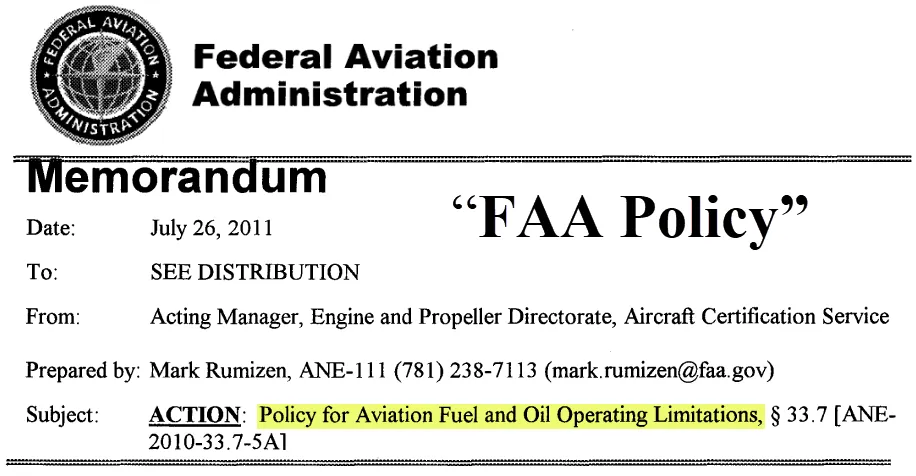
2. Background.
a. Recent environmental, cost, and supply pressures have generated aviation industry interest in developing alternative aviation fuels… ACOs and the ECO are being approached by applicants who are interested in approving new fuel or oil formulations for use on certificated aircraft and engines. In response to this increased activity, the FAA has determined that policy is necessary to clarify how we are going to evaluate certification compliance for the approval of new fuels or oils.
4. Related documents.
4. Policy.
a. …
b. …
c. When evaluating an applicant’s proposal to add a fuel or lubricant to an engine operating limitation, we will accept an ASTM International standard specification or SAE International standard, or their equivalent, as an adequate demonstration of compliance with §33.7, paragraphs (b)(2) and (c)(2) (for fuels) or §33.7, paragraphs (b)(3) and (c)(3) (for lubricants).
d. When an applicant proposes to add a fuel or lubricant to an engine operating limitation with a standard specification that is not an ASTM International standard specification or an SAE International standard, the Engine and Propeller Directorate will evaluate the applicant’s proposed standard specification to determine if it is equivalent. [i.e., equivalent to an ASTM or SAE standard.]
As a prerequisite to issuing the FAA Approved G100UL Avgas Specification and Standard, the FAA had to determine that it was the equivalent of an ASTM Consensus Standard.
S12Does G100UL Avgas meet a “Standard” that facilitates the safe use and deployment of G100UL Avgas, as that term “standard” was used in section 770 of the Congressional FAA Reauthorization Act?
Yes. It does.
To understand this subject, one must first ask the question: What is a standard? A “standard” is commonly understood to be a set of technical specifications, quality requirements, and safety criteria used to ensure that a product is made consistently, meets defined performance criteria, and is compatible with other, related, systems or products. In the case of aviation gasolines, a standard chiefly comprises a description of the chemical composition, performance characteristics, testing methods, handling procedures, labeling and documentation requirements.
In September of 2022 based, in part, on FAA Advisory Circular AC 20-24B, now AC 20-24D (see paragraph 8 e. “Independent Specifications as Operating Limitations for Aviation Fuel”), and FAA Policy Memorandum Policy for Aviation Fuel and Oil Operating Limitations, 14 CFR §33.7, the FAA approved the G100UL specification to define the standard for G100UL high octane unleaded aviation gasoline. G100UL Avgas is approved for use in all aircraft spark ignition piston engines and “nearly all” piston-engine aircraft (i.e. more than ~98%). G100UL high octane unleaded aviation gasoline is produced in compliance with a specific, FAA-approved, specification and performance criteria that constitute a “standard” as referenced under Section 770 of the FAA Reauthorization Act of 2024. The FAA approved standard for G100UL Avgas includes explicit provisions that facilitate the safe use, production, and distribution of G100UL Avgas.
